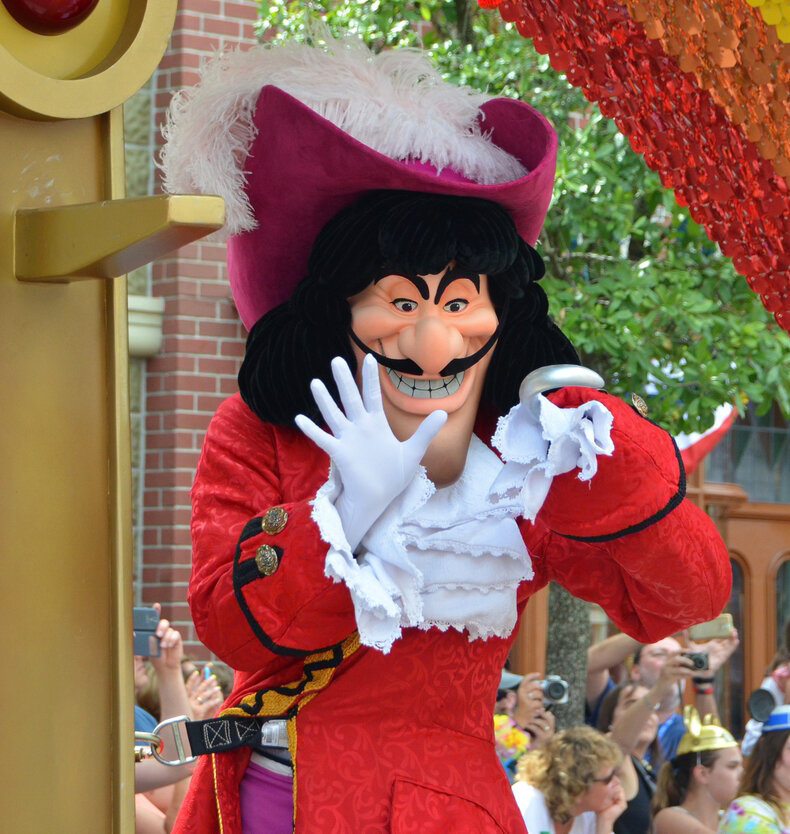Fairies in Neverland Part II: Captain Hook
The original Captain Hook is, for lack of a better term, cringeworthy. He’s loud, melodramatic, and most of his clothes are oversized. His main antagonist in life is a teenage boy. Despite commanding a ship well-armed with cannons and at least a dozen men, he lives in constant fear of a reptile that swallowed an alarm clock. He’s a villain, but also the film’s pathetic comic relief. (This was done in part to make the film less scary for young audiences). He’s also deeply queer-coded. Everything about Hook’s character, from his excess sense of fashion to his campy gestures is intended to prompt the audience into reading him as a gay man. Knowing this, it becomes worth examining how Hook - and by extension, gay men - are treated by the animators.
Excess is supposedly Hook’s flaw (and by extension, the flaw of queer people). But what feels like excess is the amount of time spent on Hook running from, getting eaten by, and escaping the Tick-Tock Croc. In the 1953 film, Hook is swallowed at least four times by the beast, only to be regurgitated shortly thereafter. Once seems reasonable - Hook falls to his doom and then escapes - but four times? And this doesn’t count the screentime Hook spends battling the reptile. The animators are torturing the villain, as is to be expected - but it drags on to the point where it’s no longer comical. While all of this occurs, Hook shrieks for Smee over and over again. The tone and frequency of Hook’s screaming suggests the animators wanted to mock Hook’s dependence on Smee - perhaps implicitly stating that feminine gay men have an almost infantile dependency on their “normal” masculine partners. Moreover, Hook’s obsession with Peter Pan reflects the predator stereotype - that gay men are obsessed with molesting and converting young boys to their “lifestyle.” Peter Pan is the epitome of childhood, an innocence that Hook is supposedly intent on ruining with his gay pirate antics.
The true artistic sin in queer coding villains (aside from homophobia) is a lack of imagination. (This is not to say that villains should never be queer - we need dynamic, fully-developed villains who just so happen to be queer some of the time - just not queerness as a core personality trait in every villain as is currently practiced). And there is so much imaginative space for Captain Hook once we no longer need to punish him for being a femme man. If Hook is no longer bound to be the piteous comic relief, he can become self-aware of his excesses. What was once poor taste becomes ironic, performative, camp. His clumsy tantrums can evolve into the strategic management practices of a femme business gay. His relationship with Smee is fertile ground for a power couple narrative and all the uncertainties that come with it - how does one navigate running a ship with their partner as first mate? That’s not a story I’ve ever seen done, gay or straight.
Aside from being more inclusive, the plot lines I’ve laid out here are all more interesting than the endless derivations of the original story that saturate the market (Pan, Return to Neverland, Hook, the list goes on). Screenwriters seem to have an ironclad faith that their particular type of reimagining - often minor character changes, aesthetic overhauls, and new high-stakes climaxes - will produce a thoroughly engaging retelling, but that is seldom the case. Nearly every Disney animated sequel fails to surpass its predecessor. Why not try something new? What’s the worst that could happen if we rewrote Peter Pan (and specifically Captain Hook) in the queer feminist imagination?
